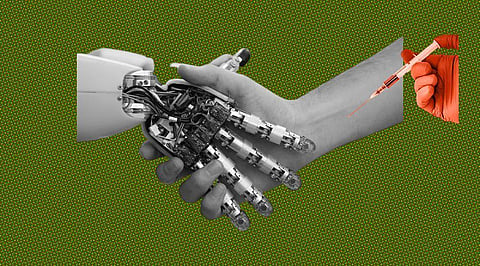

Like most of us can never be without our smartphones, robots may also soon become indispensable companions. Robots may soon replace humans as our go-to companions, just as most of us never leave home without our smartphones. Japanese researchers from the University of Tsukuba have created a hand-held, wearable soft robot that patients experience during potentially unpleasant medical treatment, procedures including vaccinations, injections, etc and it can use during treatments to lessen their discomfort.
Social soft robotics may provide a new solution for alleviating human pain and fear. Public health officials realized that during the campaign to encourage vaccination against COVID-19, public health officials recognized that some people are simply afraid of needles, which contributed to reduced vaccination rates. There is still a need to test and put into practice solutions to help patients, even though the issues of patient anxiety and pain during medical procedures have been thoroughly studied. It is well known that interpersonal touch can reduce pain and fear, and we believe that this effect can be achieved even with nonliving soft robots.
The participants of the study who wore the robot felt less pain during tests when they were exposed to a moderate heat stimulus than those who did not wear the robot. In addition, participants' fear of injections was significantly improved after participation in the experiment. These results suggest that the wearable soft robot may alleviate the human perception of pain and fear during medical treatments. However, although the body of the robot is covered in fur, and the participants can feel its softness by touch, the robot did not touch the participants, and its behavioral feedback was not manipulated.
The furry, soft robots, which the researchers called Reliebo, had tiny airbags that could inflate in response to the movements of the participant's hand. The purpose of the robot is to help ease the pain and ward off anxiety. It can be inflated to provide the wearer with a feeling of being clenched as the researchers tested its effectiveness under various scenarios, while the other arm, which wasn't being used to hold the robot, was subjected to the painful thermal stimulus. A survey test was also conducted to assess the patients' fear of injections and psychological state before and after the experiments, and subjective pain ratings were recorded using an assessment scale.
The team also measured oxycontin and cortisol levels from the participants' saliva samples, suggesting levels of stress hormones. Oxytocin and cortisol levels have been used in pain research as an objective index to assess pain levels in humans. The pain felt by the patients was given specific ratings and was also recorded using an assessment scale. This could be helpful in situations where direct human contact is impractical, like pandemics. The team also wants to eventually build an augmented reality that can allow for an actual connection to be made with the participants to further distract and deflect them from pain.
Join our WhatsApp Channel to get the latest news, exclusives and videos on WhatsApp
_____________
Disclaimer: Analytics Insight does not provide financial advice or guidance. Also note that the cryptocurrencies mentioned/listed on the website could potentially be scams, i.e. designed to induce you to invest financial resources that may be lost forever and not be recoverable once investments are made. You are responsible for conducting your own research (DYOR) before making any investments. Read more here.
